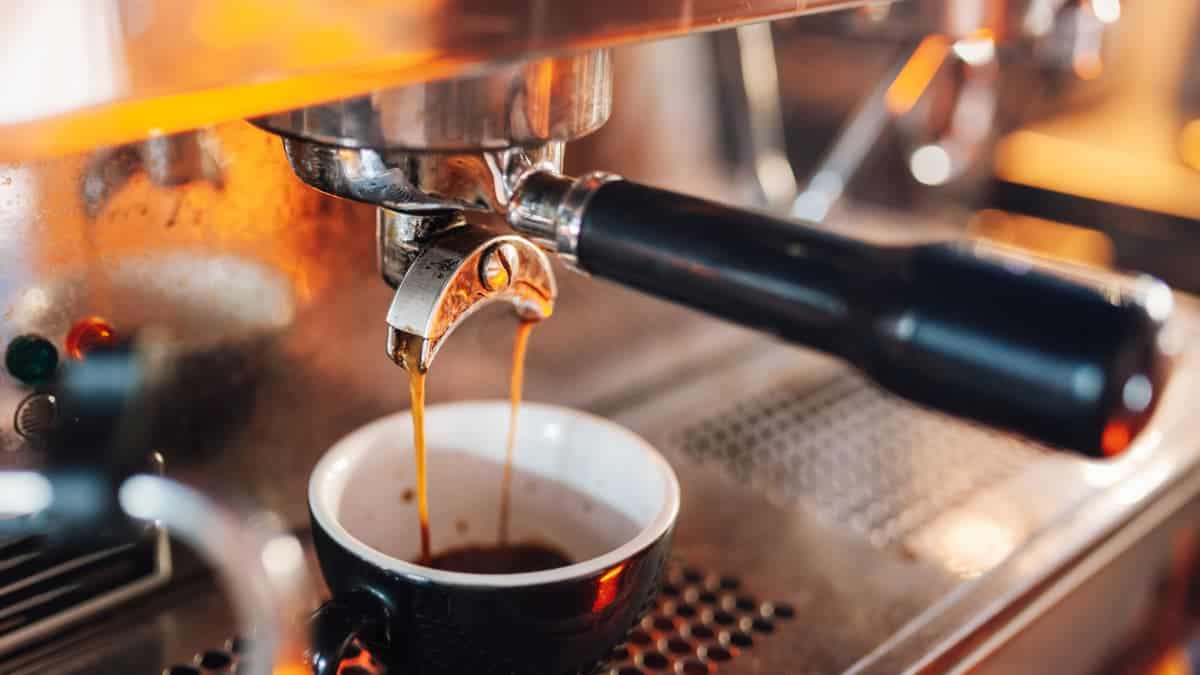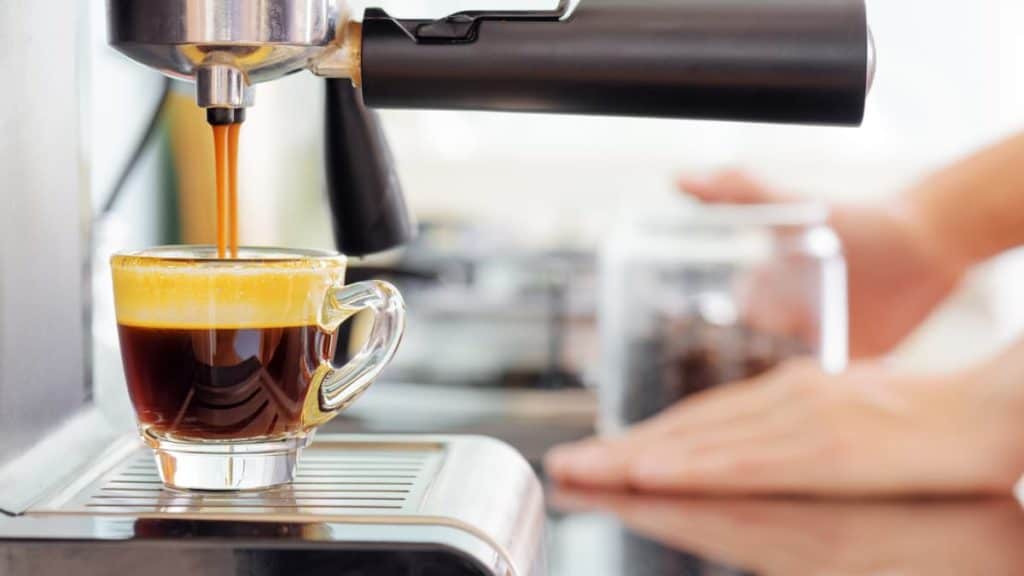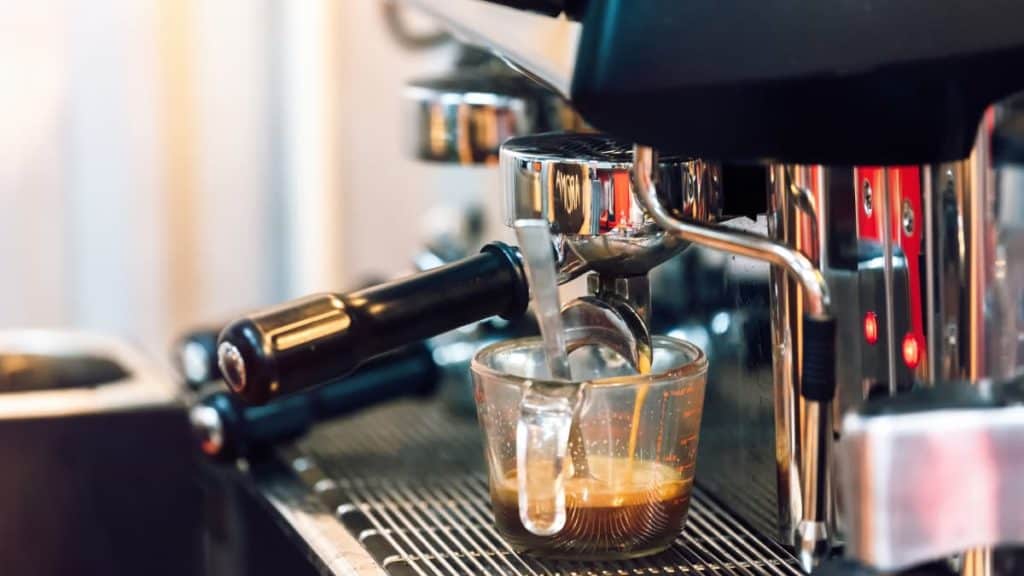Espresso Pre Infusion: Worth It Or Not?
Do you ever feel like making a humble cup of coffee is a crash course in chemistry? I get it. Phrases like pre-infusion and extraction conjure images of beakers and pipettes.
But you don’t have to be a mad scientist to appreciate the benefits of better-tasting coffee. So before you put on your lab coat, let me walk you through a simple explanation of espresso pre infusion.

What Is Pre-Infusion?
Pre-infusion refers to the act of soaking coffee grinds before extracting espresso.
First, let’s situate where we are in the process of brewing espresso. A portafilter holds ground coffee beans.
You’ve tamped these fine grounds to make an even surface. You’ve run hot water through the brew group and then you’ve clipped the portafilter into said brew group. Pre-infusion happens now, right before you extract the espresso.
This process uses a small amount of water to wet the coffee grounds as they sit in the portafilter. The water saturates the coffee grounds, preparing them for a more even extraction.
Ideally, this water will be hotter than the water used when extracting. The contact between water and the puck should occur at a lower pressure. Otherwise, you might start the extraction stage too soon.
Brewing espresso isn’t the only method that takes advantage of pre-infusion. If you’re used to making pour over coffee, you might be familiar with watching the coffee bloom.
Not familiar with this step? If you’re using a Chemex or a V60, take a look. Pre-wet the grounds sitting in the filter. Add water for the bloom, wait about thirty seconds for the gasses to release and the grounds to settle. And then add the rest of the water. Voila! Pre-infusion for pour overs.
Even an auto drip coffee machine can take advantage of this step. And many automatic espresso machines include a built-in pre-infusion feature.
Why Is Pre-Infusing Espresso Useful
The primary purpose of pre-infusion is to prevent channeling.
What’s channeling? Channeling happens when coffee absorbs water unevenly. Rather than saturating the entire coffee puck, water flows through isolated areas.
Before you head to the knockbox, look at the used puck. Do you see cracks, tiny holes, or other divots? Any of these are a sign that channeling has occurred.
Why is this a bad thing? Channeling contributes to an inconsistent extraction. An over-extracted shot will make your coffee bitter and astringent. Under-extracted coffee beans will produce a sour taste and a weak body.
Think of channeling as water trying to find the path of least resistance. Pre-infusion reduces the resistance. It helps coffee absorb water more evenly during the brewing process. And this even flow lends to a consistent extraction.
Why should you aim to achieve a complete and even extraction? Simple. A better tasting, balanced coffee. We can debate the finer techniques involved. But it’s pretty hard to argue with rich shots of espresso.

How Espresso Is Made
If you’re feeling like you missed something in Coffee 101, don’t worry. You can make espresso without pre-infusing the grinds. Here’s a quick refresher on that process.
A grinder grinds coffee beans. These grinds go from the grinder into a metal filter held within the portafilter. (Think: portable filter.) A barista, or machine, will then tamp the grounds, pressing them into a compact puck of coffee.
The espresso machine should have water heated to about 195F with 9 bars of pressure. Once the water is at temperature, the barista will flush this hot water through the group head. This flushing warms up the group head and gets rid of any old grinds hanging around.
The portafilter, containing the coffee puck, clips into the group head. Immediately after this step, the extracting begins. Hot water forces its way through the coffee puck at full pressure. The bean water then travels down the spout, trickling into the cup below.
This brewtime typically takes 25 to 30 seconds.
How To Pre-Infuse Espresso
Want to add pre-infusion to your brewing process? Awesome! Complete this step after you clip the portafilter into place. And once you finish pre-infusing the grinds, you’ll immediately start extracting.
For the sake of simplicity, let’s assume you’re using a direct plumb machine. Now that you have your portafilter in the group head, lift the brew lever part way.
This opens the pathway between the group head and the water inlet without turning on the pump.
By not engaging the pump, you’re allowing passive line pressure to push water from the boiler to the coffee. (There will be some pressure behind the water. But it will be a much lower pressure than the nine bars used to extract.)
When this water reaches the coffee, it gently saturates but does not extract the puck.
Apply this pre-infusion for two to eight seconds. (You’ll have to experiment to find the time that works best for you, the machine, and different coffees.) Then, immediately engage the pump by lifting the lever all the way.
Pre-infusing on a reservoir machine requires using a method that doesn’t rely on line pressure.
Some automatic machines include pre-infusion functions. If yours doesn’t come with this function, you will struggle to approximate the process. In some cases you can pre-infuse on a semi-automatic machine. But this will also be tricky.
One hack method is to switch the water on and then off. (And then back on to extract the coffee.) Although this method will infuse the puck with water, it will do so at full pressure. This means you run the risk of starting to extract prematurely.

How Long Does Pre-Infusing Espresso Take?
Exact pre-infusion time will vary depending on what type of espresso machine you’re using. The dosage (i.e. single or double) can also impact the time.
Many a machine have unique temperaments. So you’ll need to be the judge of the exact timing. Play around and see what works best for the machine and your taste buds.
In most cases, you’ll be aiming for a time of 2 to 8 seconds. And remember, the pre-infusion stage happens immediately before extracting. So once you hit the upper limit of your pre-infusion time, you’ll want to start extracting immediately.
Pressure Profiling
Pressure profiling is also called flow profiling. Combining these two names gives us a simple definition. This technique adjusts pressure to create an even flow of water through the puck of coffee.
During this profiling, you gradually increase water pressure from pre-infusion throughout extraction. You should reach peak water pressure right at the end of pulling the espresso shot.
Remember the dangers of channeling? This process works to achieve a similar goal. In this case, we’re trying to create a more even rate of water flow.
Think about it. A sudden spurt of pressurized water isn’t likely to flow evenly through the coffee puck. But increasing the pressure over time will help balance the extraction.
Gradual manipulation is key to successful pressure profiling. So you most likely won’t be able to achieve this technique on an automatic espresso machine.

Is Pre-Infusing Espresso Worth It?
If you have the time, equipment, and expertise to pre-infuse, go for it. You’ll only be increasing your chances of producing a rich, flavorful espresso shot.
Some people love tinkering with every step of the espresso brewing process. If that’s you, you’ll likely enjoy perfecting your pressure profiling skills.
But now I’m going to say something that aficionados will hate to hear. So long as you produce a cup of coffee you enjoy drinking, there’s no right or wrong way to brew an espresso shot.
This wisdom wavers once you start brewing for other people. But if you’re pulling an espresso shot for you and only you… Well, do what works for you.
Many beginners struggle to distribute coffee grounds evenly in the portafilter. Pre-infusion can remedy this shortcoming.
But when you’re learning on an espresso machine for the first time, you might feel overwhelmed. In this case, try to perfect the non-negotiable basics before trying pre-infusion.
Also, a quick note about trying this process on an automatic espresso machine. I love a workaround. But if you aren’t able to adjust the pressure on your machine?
Attempting to pre-infuse your espresso might not be worth your time. You might be able to approximate the process. But your results will be inconsistent if you’re not able to fine tune your process.
Wrapping Up
Great tasting coffee is the result of several chemical reactions. But you don’t need a state-of-the-art laboratory to achieve quality espresso.
Pre-infusion gets you one sip closer to sweet crema and balanced flavor. The exact technique varies depending on how you’re brewing. But pre-infusion dampens the coffee grounds to promote a more even extraction process. A process that produces tastier coffees.

